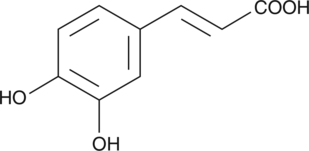Chemicals
Showing 12751–12900 of 41137 results
-
C6 NBD ceramide is a biologically active fluorescent analog of short chain, membrane-permeable ceramides.{2754} It is as effective as C6 ceramide in the inhibition of viral glycoprotein transport through the Golgi.{2754} C6 NBD ceramide has been used as a fluorescent substrate for the activity of UDP-glucose:ceramide glucosyltransferase and to demonstrate the translocation of glucocerebroside and sphingomyelin from the Golgi to the plasma membrane.{2814,3460}
Brand:CaymanSKU:62527 - 5 mgAvailable on backorder
C6 NBD ceramide is a biologically active fluorescent analog of short chain, membrane-permeable ceramides. It is as effective as C6 ceramide in the inhibition of viral glycoprotein transport through the Golgi. C6 NBD ceramide has been used as a fluorescent substrate for the activity of UDP-glucose:ceramide glucosyltransferase{2814} and to demonstrate the translocation of glucocerebroside and sphingomyelin from the Golgi to the plasma membrane.{2754,3460} C6 NBD dihydro ceramide (d18:0/6:0) is structurally identical to C6 NBD ceramide, except it contains a saturated bond in the C-4/C-5 position of the sphingosine backbone.
Brand:CaymanSKU:10007957 - 1 mgAvailable on backorder
C6 NBD ceramide is a biologically active fluorescent analog of short chain, membrane-permeable ceramides. It is as effective as C6 ceramide in the inhibition of viral glycoprotein transport through the Golgi. C6 NBD ceramide has been used as a fluorescent substrate for the activity of UDP-glucose:ceramide glucosyltransferase{2814} and to demonstrate the translocation of glucocerebroside and sphingomyelin from the Golgi to the plasma membrane.{2754,3460} C6 NBD dihydro ceramide (d18:0/6:0) is structurally identical to C6 NBD ceramide, except it contains a saturated bond in the C-4/C-5 position of the sphingosine backbone.
Brand:CaymanSKU:10007957 - 10 mgAvailable on backorder
C6 NBD ceramide is a biologically active fluorescent analog of short chain, membrane-permeable ceramides. It is as effective as C6 ceramide in the inhibition of viral glycoprotein transport through the Golgi. C6 NBD ceramide has been used as a fluorescent substrate for the activity of UDP-glucose:ceramide glucosyltransferase{2814} and to demonstrate the translocation of glucocerebroside and sphingomyelin from the Golgi to the plasma membrane.{2754,3460} C6 NBD dihydro ceramide (d18:0/6:0) is structurally identical to C6 NBD ceramide, except it contains a saturated bond in the C-4/C-5 position of the sphingosine backbone.
Brand:CaymanSKU:10007957 - 5 mgAvailable on backorder
C6 NBD galactosylceramide is a biologically active derivative of galactosylceramide that is tagged with a fluorescent C6 nitrobenzoxadiazole (C6 NBD; Item No. 18871) group.{37105} C6 NBD galactosylceramide has been used to study intracellular localization and metabolism of galactosylceramide, a sphingolipid whose synthesis is disrupted in Krabbe disease due to a deficiency of galactosylceramide β-galactosidase.{37105,37104,37106} [Matreya, LLC. Catalog No. 1621]
Brand:CaymanSKU:22830 -Out of stock
C6 NBD glucosylceramide (d18:1/6:0) is a biologically active derivative of glucosylceramide that is tagged with a fluorescent C-6 nitrobenzoxadiazole (C-6 NBD; Item No. 18871) group.{38317,38318} C6 NBD glucosylceramide (d18:1/6:0) has been used to study the metabolism and internalization of glucosylceramide. [Matreya, LLC. Catalog No. 1622]
Brand:CaymanSKU:23209 - 1 mgAvailable on backorder
C6 NBD glucosylceramide (d18:1/6:0) is a biologically active derivative of glucosylceramide that is tagged with a fluorescent C-6 nitrobenzoxadiazole (C-6 NBD; Item No. 18871) group.{38317,38318} C6 NBD glucosylceramide (d18:1/6:0) has been used to study the metabolism and internalization of glucosylceramide. [Matreya, LLC. Catalog No. 1622]
Brand:CaymanSKU:23209 - 100 µgAvailable on backorder
C6 NBD L-threo ceramide is a biologically active and cell-permeable analog of naturally occurring ceramides that is tagged with a fluorescent C6 nitrobenzoxadiazole (C6 NBD; Item No. 18871) group. It is rapidly transferred between liposomes, labels the Golgi apparatus, and is metabolized to C6 NBD sphingomyelin (Item No. 24328) in BHK cells and V79 fibroblasts.{41403} [Matreya, LLC. Catalog No. 1857]
Brand:CaymanSKU:24439 - 1 mgAvailable on backorder
C6 NBD L-threo ceramide is a biologically active and cell-permeable analog of naturally occurring ceramides that is tagged with a fluorescent C6 nitrobenzoxadiazole (C6 NBD; Item No. 18871) group. It is rapidly transferred between liposomes, labels the Golgi apparatus, and is metabolized to C6 NBD sphingomyelin (Item No. 24328) in BHK cells and V79 fibroblasts.{41403} [Matreya, LLC. Catalog No. 1857]
Brand:CaymanSKU:24439 - 100 µgAvailable on backorder
C6 NBD Lactosylceramide (d18:1/6:0) is a biologically active derivative of lactosylceramides (d18:1/acyl mixture) (Item No. 16983) that is tagged with a fluorescent C-6 nitrobenzoxadiazole (C-6 NBD; Item No. 18871) group.{37103} C6 NBD Lactosylceramide (d18:1/6:0) has been used to study the effects of P-glycoprotein inhibition in lactosylceramide metabolism-based therapeutics for the treatment of cancer. [Matreya, LLC. Catalog No. 1629]
Brand:CaymanSKU:22828 -Out of stock
C6 NBD Lactosylceramide (d18:1/6:0) is a biologically active derivative of lactosylceramides (d18:1/acyl mixture) (Item No. 16983) that is tagged with a fluorescent C-6 nitrobenzoxadiazole (C-6 NBD; Item No. 18871) group.{37103} C6 NBD Lactosylceramide (d18:1/6:0) has been used to study the effects of P-glycoprotein inhibition in lactosylceramide metabolism-based therapeutics for the treatment of cancer. [Matreya, LLC. Catalog No. 1629]
Brand:CaymanSKU:22828 -Out of stock
C6 NBD sphingomyelin is a biologically active derivative of sphingomyelin (Item Nos. 22674 | 24345) that is tagged with a fluorescent C6 nitrobenzoxadiazole (C6 NBD; Item No. 18871) group. C6 NBD sphingomyelin has been used to study the metabolism and transport of sphingomyelins.{38317,39498} It is degraded in the plasma membrane to C6 NBD ceramide (Item No. 62527) by neutral sphingomyelinase, an enzyme with three-fold higher activity in undifferentiated HT29 cells than in differentiated cells.{38317} Unlike endogenous long-chain sphingomyelin and C6 sphingomyelin, C6 NBD sphingomyelin can be transported to the cell surface even in the presence of the vesicular transport inhibitor brefeldin A (Item No. 11861), but this transport can be blocked by multidrug resistance protein inhibitors in CHO cells.{39498} This product is a mixture of the D-erythro and L-threo isomers of sphingomyelin. [Matreya, LLC. Catalog No. 1912]
Brand:CaymanSKU:24328 - 1 mgAvailable on backorder
C6 NBD sphingomyelin is a biologically active derivative of sphingomyelin (Item Nos. 22674 | 24345) that is tagged with a fluorescent C6 nitrobenzoxadiazole (C6 NBD; Item No. 18871) group. C6 NBD sphingomyelin has been used to study the metabolism and transport of sphingomyelins.{38317,39498} It is degraded in the plasma membrane to C6 NBD ceramide (Item No. 62527) by neutral sphingomyelinase, an enzyme with three-fold higher activity in undifferentiated HT29 cells than in differentiated cells.{38317} Unlike endogenous long-chain sphingomyelin and C6 sphingomyelin, C6 NBD sphingomyelin can be transported to the cell surface even in the presence of the vesicular transport inhibitor brefeldin A (Item No. 11861), but this transport can be blocked by multidrug resistance protein inhibitors in CHO cells.{39498} This product is a mixture of the D-erythro and L-threo isomers of sphingomyelin. [Matreya, LLC. Catalog No. 1912]
Brand:CaymanSKU:24328 - 100 µgAvailable on backorder
C6 Phytoceramide is a cell-permeable analog of phytoceramide (Item No. 20217). It is composed of a phytoceramide backbone amine-linked to a C6 fatty acid chain. C6 Phytoceramide induces the expression of differentiation-associated genes and promotes differentiation in keratinocytes in vitro.{36542} [Matreya, LLC. Catalog No. 1895]
Brand:CaymanSKU:24438 - 5 mgAvailable on backorder
C6 urea ceramide is an inhibitor of neutral ceramidase.{46501} It increases total ceramide levels in wild-type mouse embryonic fibroblasts (MEFs) and in HT-29 colon cancer cells but not in MEFs lacking neutral ceramidase. It inhibits proliferation of, and induces apoptosis and autophagy in HT-29, but not non-cancerous RIE-1, cells when used at concentrations of 5 and 10 µM. C6 urea ceramide decreases total β-catenin, increases phosphorylated β-catenin, and induces colocalization of β-catenin with the 20S proteasome in HT-29 and HCT116, but not RIE-1, cells. It reduces tumor growth and increases C16, C18, C20, and C24 ceramide levels in tumor tissue in an HT-29 mouse xenograft model when administered at doses of 1.25, 2.5, and 5 mg/kg for five days.
Brand:CaymanSKU:25491 - 1 mgAvailable on backorder
C6 urea ceramide is an inhibitor of neutral ceramidase.{46501} It increases total ceramide levels in wild-type mouse embryonic fibroblasts (MEFs) and in HT-29 colon cancer cells but not in MEFs lacking neutral ceramidase. It inhibits proliferation of, and induces apoptosis and autophagy in HT-29, but not non-cancerous RIE-1, cells when used at concentrations of 5 and 10 µM. C6 urea ceramide decreases total β-catenin, increases phosphorylated β-catenin, and induces colocalization of β-catenin with the 20S proteasome in HT-29 and HCT116, but not RIE-1, cells. It reduces tumor growth and increases C16, C18, C20, and C24 ceramide levels in tumor tissue in an HT-29 mouse xenograft model when administered at doses of 1.25, 2.5, and 5 mg/kg for five days.
Brand:CaymanSKU:25491 - 10 mgAvailable on backorder
C6 urea ceramide is an inhibitor of neutral ceramidase.{46501} It increases total ceramide levels in wild-type mouse embryonic fibroblasts (MEFs) and in HT-29 colon cancer cells but not in MEFs lacking neutral ceramidase. It inhibits proliferation of, and induces apoptosis and autophagy in HT-29, but not non-cancerous RIE-1, cells when used at concentrations of 5 and 10 µM. C6 urea ceramide decreases total β-catenin, increases phosphorylated β-catenin, and induces colocalization of β-catenin with the 20S proteasome in HT-29 and HCT116, but not RIE-1, cells. It reduces tumor growth and increases C16, C18, C20, and C24 ceramide levels in tumor tissue in an HT-29 mouse xenograft model when administered at doses of 1.25, 2.5, and 5 mg/kg for five days.
Brand:CaymanSKU:25491 - 5 mgAvailable on backorder
C646 is an inhibitor of the histone acetyltransferase p300 (IC50 = 1.6 μM).{18217} It competitively (versus acetyl-CoA) binds p300 (Ki = 400 nM) and does not inhibit several other acetyltransferases.{18217} The action of C646 appears to be irreversible through covalent modification of the enzyme target.{18217} It blocks the growth of human melanoma, leukemia, lung, and prostate cancer cells in vitro.{18217,22225,22222} C646 has been used to study the role of p300-mediated acetylation in such models as fear extinction memory and the regulation of immediate-early genes.{22223,22224}
Brand:CaymanSKU:10549 - 1 mgAvailable on backorder
C646 is an inhibitor of the histone acetyltransferase p300 (IC50 = 1.6 μM).{18217} It competitively (versus acetyl-CoA) binds p300 (Ki = 400 nM) and does not inhibit several other acetyltransferases.{18217} The action of C646 appears to be irreversible through covalent modification of the enzyme target.{18217} It blocks the growth of human melanoma, leukemia, lung, and prostate cancer cells in vitro.{18217,22225,22222} C646 has been used to study the role of p300-mediated acetylation in such models as fear extinction memory and the regulation of immediate-early genes.{22223,22224}
Brand:CaymanSKU:10549 - 10 mgAvailable on backorder
C646 is an inhibitor of the histone acetyltransferase p300 (IC50 = 1.6 μM).{18217} It competitively (versus acetyl-CoA) binds p300 (Ki = 400 nM) and does not inhibit several other acetyltransferases.{18217} The action of C646 appears to be irreversible through covalent modification of the enzyme target.{18217} It blocks the growth of human melanoma, leukemia, lung, and prostate cancer cells in vitro.{18217,22225,22222} C646 has been used to study the role of p300-mediated acetylation in such models as fear extinction memory and the regulation of immediate-early genes.{22223,22224}
Brand:CaymanSKU:10549 - 5 mgAvailable on backorder
C8 Ceramide (d18:1/8:0) is a cell-permeable analog of naturally occurring ceramides. Unlike C2 ceramide, it is metabolized within cells to generate natural ceramides, often causing a dramatic increase in cellular ceramide levels.{5258} For this reason, treatment of cells with C8 ceramide (d18:1/8:0) may more closely mimic the effects of ceramide elevation than does treatment with shorter chain ceramide analogs. C8 Ceramide (d18:1/8:0) likely mediates many diverse biological activities, as do natural ceramides. It promotes the differentiation of human keratinocytes{5185} and induces apoptosis of both human leukemia cells and the U937 cell line.{5258,4667}
Brand:CaymanSKU:62540 - 1 mgAvailable on backorder
C8 Ceramide (d18:1/8:0) is a cell-permeable analog of naturally occurring ceramides. Unlike C2 ceramide, it is metabolized within cells to generate natural ceramides, often causing a dramatic increase in cellular ceramide levels.{5258} For this reason, treatment of cells with C8 ceramide (d18:1/8:0) may more closely mimic the effects of ceramide elevation than does treatment with shorter chain ceramide analogs. C8 Ceramide (d18:1/8:0) likely mediates many diverse biological activities, as do natural ceramides. It promotes the differentiation of human keratinocytes{5185} and induces apoptosis of both human leukemia cells and the U937 cell line.{5258,4667}
Brand:CaymanSKU:62540 - 10 mgAvailable on backorder
C8 Ceramide (d18:1/8:0) is a cell-permeable analog of naturally occurring ceramides. Unlike C2 ceramide, it is metabolized within cells to generate natural ceramides, often causing a dramatic increase in cellular ceramide levels.{5258} For this reason, treatment of cells with C8 ceramide (d18:1/8:0) may more closely mimic the effects of ceramide elevation than does treatment with shorter chain ceramide analogs. C8 Ceramide (d18:1/8:0) likely mediates many diverse biological activities, as do natural ceramides. It promotes the differentiation of human keratinocytes{5185} and induces apoptosis of both human leukemia cells and the U937 cell line.{5258,4667}
Brand:CaymanSKU:62540 - 25 mgAvailable on backorder
C8 Ceramide (d18:1/8:0) is a cell-permeable analog of naturally occurring ceramides. Unlike C2 ceramide, it is metabolized within cells to generate natural ceramides, often causing a dramatic increase in cellular ceramide levels.{5258} For this reason, treatment of cells with C8 ceramide (d18:1/8:0) may more closely mimic the effects of ceramide elevation than does treatment with shorter chain ceramide analogs. C8 Ceramide (d18:1/8:0) likely mediates many diverse biological activities, as do natural ceramides. It promotes the differentiation of human keratinocytes{5185} and induces apoptosis of both human leukemia cells and the U937 cell line.{5258,4667}
Brand:CaymanSKU:62540 - 5 mgAvailable on backorder
C8 ceramide-1-phosphate is a short-chain analog of the naturally occurring ceramide-1-phosphate. The effects of C8 ceramide-1-phosphate are essentially the opposite of C8 ceramide; it induces DNA synthesis and cell division. The effects of C8 ceramide-1-phosphate can be attenuated by simultaneous treatment with C2 or C8 ceramide.{5183}
Brand:CaymanSKU:62547 - 1 mgAvailable on backorder
C8 ceramide-1-phosphate is a short-chain analog of the naturally occurring ceramide-1-phosphate. The effects of C8 ceramide-1-phosphate are essentially the opposite of C8 ceramide; it induces DNA synthesis and cell division. The effects of C8 ceramide-1-phosphate can be attenuated by simultaneous treatment with C2 or C8 ceramide.{5183}
Brand:CaymanSKU:62547 - 10 mgAvailable on backorder
C8 ceramide-1-phosphate is a short-chain analog of the naturally occurring ceramide-1-phosphate. The effects of C8 ceramide-1-phosphate are essentially the opposite of C8 ceramide; it induces DNA synthesis and cell division. The effects of C8 ceramide-1-phosphate can be attenuated by simultaneous treatment with C2 or C8 ceramide.{5183}
Brand:CaymanSKU:62547 - 25 mgAvailable on backorder
C8 ceramide-1-phosphate is a short-chain analog of the naturally occurring ceramide-1-phosphate. The effects of C8 ceramide-1-phosphate are essentially the opposite of C8 ceramide; it induces DNA synthesis and cell division. The effects of C8 ceramide-1-phosphate can be attenuated by simultaneous treatment with C2 or C8 ceramide.{5183}
Brand:CaymanSKU:62547 - 5 mgAvailable on backorder
C8 Ceramine is an analog of C8 ceramide (Item No. 62540) in which the carbonyl group of the ceramide is replaced by a methylene group. At a concentration of 10 µM, C8 ceramine induces maximal DNA fragmentation in U937 cells after 6 hours of incubation, compared to 12 hours for C8 ceramide.{5258}
Brand:CaymanSKU:62545 - 1 mgAvailable on backorder
C8 Ceramine is an analog of C8 ceramide (Item No. 62540) in which the carbonyl group of the ceramide is replaced by a methylene group. At a concentration of 10 µM, C8 ceramine induces maximal DNA fragmentation in U937 cells after 6 hours of incubation, compared to 12 hours for C8 ceramide.{5258}
Brand:CaymanSKU:62545 - 10 mgAvailable on backorder
C8 Ceramine is an analog of C8 ceramide (Item No. 62540) in which the carbonyl group of the ceramide is replaced by a methylene group. At a concentration of 10 µM, C8 ceramine induces maximal DNA fragmentation in U937 cells after 6 hours of incubation, compared to 12 hours for C8 ceramide.{5258}
Brand:CaymanSKU:62545 - 5 mgAvailable on backorder
C8 D-threo Ceramide is a bioactive sphingolipid and cell-permeable analog of naturally occurring ceramides.{5258} It is cytotoxic to U937 cells (IC50 = 17 μM) and induces nuclear DNA fragmentation 5- to 6-fold more potently than C8 ceramide (Item No. 62540).{5258,38647} C8 D-threo Ceramide is a substrate for E. coli diacylglycerol kinase.{5258} It activates ceramide-activated protein kinase (CAPK) in U937 cells. C8 D-threo Ceramide also enhances V. cholerae cytolysin pore formation in liposome lipid membranes, as measured by calcein release, with a 50% release dose (RD50) value of ~5 μg/ml.{40652} [Matreya, LLC. Catalog No. 1810]
Brand:CaymanSKU:24391 - 1 mgAvailable on backorder
C8 dihydro Ceramide is a sphingolipid and an intermediate in the synthesis of C8 ceramide (Item No. 62540).{36404} It is synthesized by the acylation of sphinganine by ceramide synthase, a process that can be inhibited by some fungal mycotoxins, such as fumonisin B1 (Item No. 62580).{5545} C8 dihydro Ceramide can be converted to C8 ceramide via the introduction of a 4,5-trans double bond by dihydroceramide desaturase.{36404} C8 dihydro ceramide is metabolically inactive and has been used as a negative control for the biological activity of C8 ceramide.{36405} [Matreya, LLC. Catalog No. 1854]
Brand:CaymanSKU:24358 - 1 mgAvailable on backorder
C8 dihydro Ceramide is a sphingolipid and an intermediate in the synthesis of C8 ceramide (Item No. 62540).{36404} It is synthesized by the acylation of sphinganine by ceramide synthase, a process that can be inhibited by some fungal mycotoxins, such as fumonisin B1 (Item No. 62580).{5545} C8 dihydro Ceramide can be converted to C8 ceramide via the introduction of a 4,5-trans double bond by dihydroceramide desaturase.{36404} C8 dihydro ceramide is metabolically inactive and has been used as a negative control for the biological activity of C8 ceramide.{36405} [Matreya, LLC. Catalog No. 1854]
Brand:CaymanSKU:24358 - 5 mgAvailable on backorder
C8 Galactosylceramide is a synthetic C8 short-chain derivative of known membrane microdomain-forming sphingolipids.{37368} It increases the amount delivered and toxicity of doxorubicin (Item No. 15007) in cancerous but not non-cancerous cells when incorporated into the nanoliposomal membrane of nanoliposomal-doxorubicin. C8 Galactosylceramide induces proliferation and cytokine production by splenocytes in vitro at concentrations ranging from 100-1,000 ng/ml but has no effect on natural killer T cell production in vivo.{37369} It also activates NF-κB production in C6 glioma cells when used at a concentration of 10 μM.{38647} [Matreya, LLC. Catalog No. 1334]
Brand:CaymanSKU:24346 - 10 mgAvailable on backorder
C8 L-threo Ceramide is a bioactive sphingolipid and cell-permeable analog of naturally occurring ceramides.{5258} It is cytotoxic to U937 cells (IC50 = 10 μM) and, like C8 D-threo ceramide (Item No. 24391), induces nuclear DNA fragmentation 5- to 6-fold more potently than C8 L-erythro ceramide (Item No. 62540).{38647,5258} C8 D-threo Ceramide also enhances V. cholerae cytolysin pore formation in liposome lipid membranes, as measured by calcein release, with a 50% release dose (RD50) value of ~30 μg/ml.{40652} [Matreya, LLC. Catalog No. 1830]
Brand:CaymanSKU:24392 - 1 mgAvailable on backorder
C8 Phytoceramide is a cell-permeable analog of phytosphingosine (Item No. 20217). It is composed of a phytosphingosine backbone amine-linked to a C8 fatty acid chain. C8 Phytoceramide has been used as a standard for the determination of ceramides in commercial cosmetics using LC-MS.{40693} [Matreya, LLC. Catalog No. 1894]
Brand:CaymanSKU:24357 - 5 mgAvailable on backorder
CA-074 is a selective epoxysuccinyl peptide inhibitor of the cysteine protease cathepsin B (Kis = 0.0087, 75, and 233 μM for rat cathepsin B, H, and L, respectively).{14250} It inhibits degradation of DQ-collagen IV and DQ-collagen I in 4T1.2 breast cancer cells in a concentration-dependent manner and reduces the number of lung and bone metastasis in a 4T1.2 mouse xenograft model, without affecting primary tumor growth, when administered at a dose of 50 mg/kg.{41935} CA-074 (0.1 and 0.2 mg/animal per day) reduces mercury-induced increases in expression of TNF-α, IL-1β, and the inflammasome component NRLP3 and decreases the severity of mercury-induced skin induration in mice.{41937} CA-074 also reduces ischemia-induced hippocampal neuron cell death in monkeys.{41936}
Brand:CaymanSKU:24679 - 1 mgAvailable on backorder
CA-074 is a selective epoxysuccinyl peptide inhibitor of the cysteine protease cathepsin B (Kis = 0.0087, 75, and 233 μM for rat cathepsin B, H, and L, respectively).{14250} It inhibits degradation of DQ-collagen IV and DQ-collagen I in 4T1.2 breast cancer cells in a concentration-dependent manner and reduces the number of lung and bone metastasis in a 4T1.2 mouse xenograft model, without affecting primary tumor growth, when administered at a dose of 50 mg/kg.{41935} CA-074 (0.1 and 0.2 mg/animal per day) reduces mercury-induced increases in expression of TNF-α, IL-1β, and the inflammasome component NRLP3 and decreases the severity of mercury-induced skin induration in mice.{41937} CA-074 also reduces ischemia-induced hippocampal neuron cell death in monkeys.{41936}
Brand:CaymanSKU:24679 - 500 µgAvailable on backorder
CA-074 methyl ester is a cell-permeable inhibitor of cathepsin B and L in vivo and in whole cells.{29705,29706} The methyl ester is hydrolyzed by intracellular esterases releasing the active inhibitor, CA-074. This compound has primarily been used to study the role of cathepsin B in neurodegeneration, cancer cell metastasis, necrosis, and rheumatoid arthritis.{29704,29707,29703,29708}
Brand:CaymanSKU:-Available on backorder
CA-074 methyl ester is a cell-permeable inhibitor of cathepsin B and L in vivo and in whole cells.{29705,29706} The methyl ester is hydrolyzed by intracellular esterases releasing the active inhibitor, CA-074. This compound has primarily been used to study the role of cathepsin B in neurodegeneration, cancer cell metastasis, necrosis, and rheumatoid arthritis.{29704,29707,29703,29708}
Brand:CaymanSKU:-Available on backorder
CA-074 methyl ester is a cell-permeable inhibitor of cathepsin B and L in vivo and in whole cells.{29705,29706} The methyl ester is hydrolyzed by intracellular esterases releasing the active inhibitor, CA-074. This compound has primarily been used to study the role of cathepsin B in neurodegeneration, cancer cell metastasis, necrosis, and rheumatoid arthritis.{29704,29707,29703,29708}
Brand:CaymanSKU:-Available on backorder
CA-4948 is an orally bioavailable inhibitor of interleukin-1 receptor associated kinase-4 (IRAK-4).{47531} It has antitumor activity in ABC-type diffuse large B cell lymphoma patient-derived xenograft (PDX) mouse models.
Brand:CaymanSKU:27598 - 1 mgAvailable on backorder
CA-4948 is an orally bioavailable inhibitor of interleukin-1 receptor associated kinase-4 (IRAK-4).{47531} It has antitumor activity in ABC-type diffuse large B cell lymphoma patient-derived xenograft (PDX) mouse models.
Brand:CaymanSKU:27598 - 10 mgAvailable on backorder
CA-4948 is an orally bioavailable inhibitor of interleukin-1 receptor associated kinase-4 (IRAK-4).{47531} It has antitumor activity in ABC-type diffuse large B cell lymphoma patient-derived xenograft (PDX) mouse models.
Brand:CaymanSKU:27598 - 25 mgAvailable on backorder
CA-4948 is an orally bioavailable inhibitor of interleukin-1 receptor associated kinase-4 (IRAK-4).{47531} It has antitumor activity in ABC-type diffuse large B cell lymphoma patient-derived xenograft (PDX) mouse models.
Brand:CaymanSKU:27598 - 5 mgAvailable on backorder
Cabazitaxel is a second generation semisynthetic taxane derived from 10-deacetylbaccatin III (Item No. 22261).{36093} It stabilizes microtubule assembly by reducing lag time for tubulin assembly (LT50 = 100 nM) and the rate of cold-induced microtubule depolymerization (IC50s = 100-250 nM) in vitro. Cabazitaxel inhibits proliferation of P388, HL-60, Calc18, and KB cells (IC50s = 4-41 nM), as well as P-glycoprotein-expressing, drug-resistant versions of these cell lines (IC50s = 16-414 nM). In vivo, cabazitaxel dose-dependently reduces tumor growth in docetaxel-susceptible N87 human gastric carcinoma and docetaxel-resistant UISO BCA-1 breast cancer mouse xenograft models. Formulations containing cabazitaxel have been used in combination with prednisone in the treatment of hormone-refractory metastatic prostate cancer.
Brand:CaymanSKU:22262 -Out of stock
Cabazitaxel is a second generation semisynthetic taxane derived from 10-deacetylbaccatin III (Item No. 22261).{36093} It stabilizes microtubule assembly by reducing lag time for tubulin assembly (LT50 = 100 nM) and the rate of cold-induced microtubule depolymerization (IC50s = 100-250 nM) in vitro. Cabazitaxel inhibits proliferation of P388, HL-60, Calc18, and KB cells (IC50s = 4-41 nM), as well as P-glycoprotein-expressing, drug-resistant versions of these cell lines (IC50s = 16-414 nM). In vivo, cabazitaxel dose-dependently reduces tumor growth in docetaxel-susceptible N87 human gastric carcinoma and docetaxel-resistant UISO BCA-1 breast cancer mouse xenograft models. Formulations containing cabazitaxel have been used in combination with prednisone in the treatment of hormone-refractory metastatic prostate cancer.
Brand:CaymanSKU:22262 -Out of stock
Cabazitaxel is a second generation semisynthetic taxane derived from 10-deacetylbaccatin III (Item No. 22261).{36093} It stabilizes microtubule assembly by reducing lag time for tubulin assembly (LT50 = 100 nM) and the rate of cold-induced microtubule depolymerization (IC50s = 100-250 nM) in vitro. Cabazitaxel inhibits proliferation of P388, HL-60, Calc18, and KB cells (IC50s = 4-41 nM), as well as P-glycoprotein-expressing, drug-resistant versions of these cell lines (IC50s = 16-414 nM). In vivo, cabazitaxel dose-dependently reduces tumor growth in docetaxel-susceptible N87 human gastric carcinoma and docetaxel-resistant UISO BCA-1 breast cancer mouse xenograft models. Formulations containing cabazitaxel have been used in combination with prednisone in the treatment of hormone-refractory metastatic prostate cancer.
Brand:CaymanSKU:22262 -Out of stock
Cabazitaxel is a second generation semisynthetic taxane derived from 10-deacetylbaccatin III (Item No. 22261).{36093} It stabilizes microtubule assembly by reducing lag time for tubulin assembly (LT50 = 100 nM) and the rate of cold-induced microtubule depolymerization (IC50s = 100-250 nM) in vitro. Cabazitaxel inhibits proliferation of P388, HL-60, Calc18, and KB cells (IC50s = 4-41 nM), as well as P-glycoprotein-expressing, drug-resistant versions of these cell lines (IC50s = 16-414 nM). In vivo, cabazitaxel dose-dependently reduces tumor growth in docetaxel-susceptible N87 human gastric carcinoma and docetaxel-resistant UISO BCA-1 breast cancer mouse xenograft models. Formulations containing cabazitaxel have been used in combination with prednisone in the treatment of hormone-refractory metastatic prostate cancer.
Brand:CaymanSKU:22262 -Out of stock
Cabazitaxel-d9 is intended for use as an internal standard for the quantification of cabazitaxel (Item No. 22262) by GC- or LC-MS. Cabazitaxel is a second generation semisynthetic taxane derived from 10-deacetylbaccatin III (Item No. 22261).{36093} It stabilizes microtubule assembly by reducing lag time for tubulin assembly (LT50 = 100 nM) and the rate of cold-induced microtubule depolymerization (IC50s = 100-250 nM) in vitro. Cabazitaxel inhibits proliferation of P388, HL-60, Calc18, and KB cells (IC50s = 4-41 nM), as well as P-glycoprotein-expressing, drug-resistant versions of these cell lines (IC50s = 16-414 nM). In vivo, cabazitaxel dose-dependently reduces tumor growth in docetaxel-susceptible N87 human gastric carcinoma and docetaxel-resistant UISO BCA-1 breast cancer mouse xenograft models. Formulations containing cabazitaxel have been used in combination with prednisone in the treatment of hormone-refractory metastatic prostate cancer.
Brand:CaymanSKU:28488 - 1 mgAvailable on backorder
Cabazitaxel-d9 is intended for use as an internal standard for the quantification of cabazitaxel (Item No. 22262) by GC- or LC-MS. Cabazitaxel is a second generation semisynthetic taxane derived from 10-deacetylbaccatin III (Item No. 22261).{36093} It stabilizes microtubule assembly by reducing lag time for tubulin assembly (LT50 = 100 nM) and the rate of cold-induced microtubule depolymerization (IC50s = 100-250 nM) in vitro. Cabazitaxel inhibits proliferation of P388, HL-60, Calc18, and KB cells (IC50s = 4-41 nM), as well as P-glycoprotein-expressing, drug-resistant versions of these cell lines (IC50s = 16-414 nM). In vivo, cabazitaxel dose-dependently reduces tumor growth in docetaxel-susceptible N87 human gastric carcinoma and docetaxel-resistant UISO BCA-1 breast cancer mouse xenograft models. Formulations containing cabazitaxel have been used in combination with prednisone in the treatment of hormone-refractory metastatic prostate cancer.
Brand:CaymanSKU:28488 - 5 mgAvailable on backorder
Cabergoline is a potent and selective dopamine D2 receptor agonist (Kis = 0.912 and 6,935 nM for D2 and D1 receptors, respectively, in rat striatum) that inhibits the secretion of prolactin (PRL) and growth hormone.{41336,41337} It inhibits PRL secretion in and growth of rat pituitary tumor cells in a concentration-dependent manner, an effect which can be reversed by the dopamine D2 receptor antagonist haloperidol (Item No. 12014).{41337} Cabergoline suppresses the mammalian target of rapamycin (mTOR) signaling pathway in a time-dependent manner and induces autophagy and cell death in MMQ and GH3 rat pituitary cells.{41338} In vivo, cabergoline (0.25 mg/kg) stimulates motor activity and decreases dyskinesias in a monkey model of Parkinson’s disease induced by MPTP.{41339} Formulations containing cabergoline have been used to treat prolactinomas.
Brand:CaymanSKU:23934 - 1 mgAvailable on backorder
Cabergoline is a potent and selective dopamine D2 receptor agonist (Kis = 0.912 and 6,935 nM for D2 and D1 receptors, respectively, in rat striatum) that inhibits the secretion of prolactin (PRL) and growth hormone.{41336,41337} It inhibits PRL secretion in and growth of rat pituitary tumor cells in a concentration-dependent manner, an effect which can be reversed by the dopamine D2 receptor antagonist haloperidol (Item No. 12014).{41337} Cabergoline suppresses the mammalian target of rapamycin (mTOR) signaling pathway in a time-dependent manner and induces autophagy and cell death in MMQ and GH3 rat pituitary cells.{41338} In vivo, cabergoline (0.25 mg/kg) stimulates motor activity and decreases dyskinesias in a monkey model of Parkinson’s disease induced by MPTP.{41339} Formulations containing cabergoline have been used to treat prolactinomas.
Brand:CaymanSKU:23934 - 10 mgAvailable on backorder
Cabergoline is a potent and selective dopamine D2 receptor agonist (Kis = 0.912 and 6,935 nM for D2 and D1 receptors, respectively, in rat striatum) that inhibits the secretion of prolactin (PRL) and growth hormone.{41336,41337} It inhibits PRL secretion in and growth of rat pituitary tumor cells in a concentration-dependent manner, an effect which can be reversed by the dopamine D2 receptor antagonist haloperidol (Item No. 12014).{41337} Cabergoline suppresses the mammalian target of rapamycin (mTOR) signaling pathway in a time-dependent manner and induces autophagy and cell death in MMQ and GH3 rat pituitary cells.{41338} In vivo, cabergoline (0.25 mg/kg) stimulates motor activity and decreases dyskinesias in a monkey model of Parkinson’s disease induced by MPTP.{41339} Formulations containing cabergoline have been used to treat prolactinomas.
Brand:CaymanSKU:23934 - 5 mgAvailable on backorder
Cabergoline is a potent and selective dopamine D2 receptor agonist (Kis = 0.912 and 6,935 nM for D2 and D1 receptors, respectively, in rat striatum) that inhibits the secretion of prolactin (PRL) and growth hormone.{41336,41337} It inhibits PRL secretion in and growth of rat pituitary tumor cells in a concentration-dependent manner, an effect which can be reversed by the dopamine D2 receptor antagonist haloperidol (Item No. 12014).{41337} Cabergoline suppresses the mammalian target of rapamycin (mTOR) signaling pathway in a time-dependent manner and induces autophagy and cell death in MMQ and GH3 rat pituitary cells.{41338} In vivo, cabergoline (0.25 mg/kg) stimulates motor activity and decreases dyskinesias in a monkey model of Parkinson’s disease induced by MPTP.{41339} Formulations containing cabergoline have been used to treat prolactinomas.
Brand:CaymanSKU:23934 - 50 mgAvailable on backorder
Cabotegravir is an inhibitor of HIV-1 integrase (IC50 = 3 nM in a strand transfer assay).{45297} It inhibits HIV replication in MT-4 cells and peripheral blood mononuclear cells (PBMCs; IC50s = 1.3 and 0.2 nM, respectively). Cabotegravir (50 mg/kg) is protective against simian/human immunodeficiency virus (SHIV) infection in macaques when administered 1 week prior to viral challenge.{45298}
Brand:CaymanSKU:27215 - 10 mgAvailable on backorder
Cabotegravir is an inhibitor of HIV-1 integrase (IC50 = 3 nM in a strand transfer assay).{45297} It inhibits HIV replication in MT-4 cells and peripheral blood mononuclear cells (PBMCs; IC50s = 1.3 and 0.2 nM, respectively). Cabotegravir (50 mg/kg) is protective against simian/human immunodeficiency virus (SHIV) infection in macaques when administered 1 week prior to viral challenge.{45298}
Brand:CaymanSKU:27215 - 25 mgAvailable on backorder
Cabotegravir is an inhibitor of HIV-1 integrase (IC50 = 3 nM in a strand transfer assay).{45297} It inhibits HIV replication in MT-4 cells and peripheral blood mononuclear cells (PBMCs; IC50s = 1.3 and 0.2 nM, respectively). Cabotegravir (50 mg/kg) is protective against simian/human immunodeficiency virus (SHIV) infection in macaques when administered 1 week prior to viral challenge.{45298}
Brand:CaymanSKU:27215 - 5 mgAvailable on backorder
Cabotegravir is an inhibitor of HIV-1 integrase (IC50 = 3 nM in a strand transfer assay).{45297} It inhibits HIV replication in MT-4 cells and peripheral blood mononuclear cells (PBMCs; IC50s = 1.3 and 0.2 nM, respectively). Cabotegravir (50 mg/kg) is protective against simian/human immunodeficiency virus (SHIV) infection in macaques when administered 1 week prior to viral challenge.{45298}
Brand:CaymanSKU:27215 - 50 mgAvailable on backorder
CaCC(inh)-A01 is a non-selective inhibitor of calcium-activated chloride channels (CaCCs) that blocks ATP-stimulated chloride conductance in human salivary gland, intestinal, and bronchial epithelium (mean IC50 = 10 µM).{37016} CaCC(inh)-A01 (30 µM) induces full vasorelaxation of preconstricted mouse isolated mesenteric arteries in the presence or absence of chloride.{34635} CaCC(inh)-A01 also attenuates CaCC TMEM16-A-induced proliferation in cancer cell lines through targeted degradation of the protein and reduces BKCa channel activity in human red blood cells.{37017},{37018}
Brand:CaymanSKU:21922 -Out of stock
CaCC(inh)-A01 is a non-selective inhibitor of calcium-activated chloride channels (CaCCs) that blocks ATP-stimulated chloride conductance in human salivary gland, intestinal, and bronchial epithelium (mean IC50 = 10 µM).{37016} CaCC(inh)-A01 (30 µM) induces full vasorelaxation of preconstricted mouse isolated mesenteric arteries in the presence or absence of chloride.{34635} CaCC(inh)-A01 also attenuates CaCC TMEM16-A-induced proliferation in cancer cell lines through targeted degradation of the protein and reduces BKCa channel activity in human red blood cells.{37017},{37018}
Brand:CaymanSKU:21922 -Out of stock
CaCC(inh)-A01 is a non-selective inhibitor of calcium-activated chloride channels (CaCCs) that blocks ATP-stimulated chloride conductance in human salivary gland, intestinal, and bronchial epithelium (mean IC50 = 10 µM).{37016} CaCC(inh)-A01 (30 µM) induces full vasorelaxation of preconstricted mouse isolated mesenteric arteries in the presence or absence of chloride.{34635} CaCC(inh)-A01 also attenuates CaCC TMEM16-A-induced proliferation in cancer cell lines through targeted degradation of the protein and reduces BKCa channel activity in human red blood cells.{37017},{37018}
Brand:CaymanSKU:21922 -Out of stock
CaCC(inh)-A01 is a non-selective inhibitor of calcium-activated chloride channels (CaCCs) that blocks ATP-stimulated chloride conductance in human salivary gland, intestinal, and bronchial epithelium (mean IC50 = 10 µM).{37016} CaCC(inh)-A01 (30 µM) induces full vasorelaxation of preconstricted mouse isolated mesenteric arteries in the presence or absence of chloride.{34635} CaCC(inh)-A01 also attenuates CaCC TMEM16-A-induced proliferation in cancer cell lines through targeted degradation of the protein and reduces BKCa channel activity in human red blood cells.{37017},{37018}
Brand:CaymanSKU:21922 -Out of stock
Cacodylic acid has been widely used in buffers for electron microscopy techniques.{36150} It has also been used to introduce arsenic into proteins for single-wavelength anomalous diffraction (SAD) phasing in protein crystallography.{36147} Cacodylic acid has also been used as an herbicide, acting as a defoliant.{36148} In rats exposed to carcinogens, cacodylic acid increases the likelihood of tumor formation in the bladder, kidney, liver, and thyroid gland at concentrations as low as 50 ppm for the bladder.{36149}
Brand:CaymanSKU:22996 - 100 mgAvailable on backorder
Cacodylic acid has been widely used in buffers for electron microscopy techniques.{36150} It has also been used to introduce arsenic into proteins for single-wavelength anomalous diffraction (SAD) phasing in protein crystallography.{36147} Cacodylic acid has also been used as an herbicide, acting as a defoliant.{36148} In rats exposed to carcinogens, cacodylic acid increases the likelihood of tumor formation in the bladder, kidney, liver, and thyroid gland at concentrations as low as 50 ppm for the bladder.{36149}
Brand:CaymanSKU:22996 - 50 mgAvailable on backorder
Cadazolid is an oxazolidinone-type antibiotic that has activity against a panel of C. difficile strains, including those resistant to fluoroquinolones and linezolid (Item No. 15012; MICs = 0.125-0.5 μg/ml).{43211} It inhibits toxin A and B formation in stationary-phase cultures and spore formation in late exponential cultures of the toxigenic C. difficile strain ATCC 9689. Cadazolid inhibits C. difficile protein synthesis (IC50s = 0.08-0.31 μg/ml) without affecting nucleic acid or cell wall synthesis (IC50s = 12-18.6 and >32 μg/ml, respectively).{43212} In vivo, cadazolid (1 and 10 mg/kg) increases survival in a mouse model of C. difficile-associated diarrhea (CDAD). It also confers 100% survival in a hamster model of CDAD when administered at doses greater than 3 mg/kg.{43211}
Brand:CaymanSKU:23030 - 1 mgAvailable on backorder
Cadazolid is an oxazolidinone-type antibiotic that has activity against a panel of C. difficile strains, including those resistant to fluoroquinolones and linezolid (Item No. 15012; MICs = 0.125-0.5 μg/ml).{43211} It inhibits toxin A and B formation in stationary-phase cultures and spore formation in late exponential cultures of the toxigenic C. difficile strain ATCC 9689. Cadazolid inhibits C. difficile protein synthesis (IC50s = 0.08-0.31 μg/ml) without affecting nucleic acid or cell wall synthesis (IC50s = 12-18.6 and >32 μg/ml, respectively).{43212} In vivo, cadazolid (1 and 10 mg/kg) increases survival in a mouse model of C. difficile-associated diarrhea (CDAD). It also confers 100% survival in a hamster model of CDAD when administered at doses greater than 3 mg/kg.{43211}
Brand:CaymanSKU:23030 - 10 mgAvailable on backorder
Cadazolid is an oxazolidinone-type antibiotic that has activity against a panel of C. difficile strains, including those resistant to fluoroquinolones and linezolid (Item No. 15012; MICs = 0.125-0.5 μg/ml).{43211} It inhibits toxin A and B formation in stationary-phase cultures and spore formation in late exponential cultures of the toxigenic C. difficile strain ATCC 9689. Cadazolid inhibits C. difficile protein synthesis (IC50s = 0.08-0.31 μg/ml) without affecting nucleic acid or cell wall synthesis (IC50s = 12-18.6 and >32 μg/ml, respectively).{43212} In vivo, cadazolid (1 and 10 mg/kg) increases survival in a mouse model of C. difficile-associated diarrhea (CDAD). It also confers 100% survival in a hamster model of CDAD when administered at doses greater than 3 mg/kg.{43211}
Brand:CaymanSKU:23030 - 25 mgAvailable on backorder
Cadazolid is an oxazolidinone-type antibiotic that has activity against a panel of C. difficile strains, including those resistant to fluoroquinolones and linezolid (Item No. 15012; MICs = 0.125-0.5 μg/ml).{43211} It inhibits toxin A and B formation in stationary-phase cultures and spore formation in late exponential cultures of the toxigenic C. difficile strain ATCC 9689. Cadazolid inhibits C. difficile protein synthesis (IC50s = 0.08-0.31 μg/ml) without affecting nucleic acid or cell wall synthesis (IC50s = 12-18.6 and >32 μg/ml, respectively).{43212} In vivo, cadazolid (1 and 10 mg/kg) increases survival in a mouse model of C. difficile-associated diarrhea (CDAD). It also confers 100% survival in a hamster model of CDAD when administered at doses greater than 3 mg/kg.{43211}
Brand:CaymanSKU:23030 - 5 mgAvailable on backorder
Caerulomycin A is an fungal metabolite originally isolated from Actinoalloteichus with antifungal and immunosuppressant activites.{47448,47449,47450,47451} It inhibits the growth of C. albicans, C. glabrata, and C. krusei (MICs = 0.78-1.56, 0.39-0.78, and 0.78-1.56 μg/ml, respectively).{47448} Caerulomycin A induces expansion of CD4+Foxp3+ regulatory T cells (Tregs) and decreases the number of Th1 and T17 cells in vitro via increased TGF-β-mediated Smad3 activity and reduces IFN-γ-induced STAT1 signaling.{47449} In vivo, caerulomycin A (10 mg/kg) reduces IL-6, TNF-α, and IFN-γ production, inflammation, and synovitis in a mouse model of collagen-induced arthritis. Caerulomycin A suppresses the differentiation of Th2 cells and reduces levels of IL-4, IL-5, IL-13, and IgE and eosinophil lung infiltration in a mouse model of ovalbumin-induced asthma.{47450} It also increases production of Tregs, reduces production of Th1, Th17, and CD8 T cells, and reduces disease severity in a mouse model of experimental autoimmune encephalomyelitis (EAE).{47451}
Brand:CaymanSKU:27625 - 1 mgAvailable on backorder
Caerulomycin A is an fungal metabolite originally isolated from Actinoalloteichus with antifungal and immunosuppressant activites.{47448,47449,47450,47451} It inhibits the growth of C. albicans, C. glabrata, and C. krusei (MICs = 0.78-1.56, 0.39-0.78, and 0.78-1.56 μg/ml, respectively).{47448} Caerulomycin A induces expansion of CD4+Foxp3+ regulatory T cells (Tregs) and decreases the number of Th1 and T17 cells in vitro via increased TGF-β-mediated Smad3 activity and reduces IFN-γ-induced STAT1 signaling.{47449} In vivo, caerulomycin A (10 mg/kg) reduces IL-6, TNF-α, and IFN-γ production, inflammation, and synovitis in a mouse model of collagen-induced arthritis. Caerulomycin A suppresses the differentiation of Th2 cells and reduces levels of IL-4, IL-5, IL-13, and IgE and eosinophil lung infiltration in a mouse model of ovalbumin-induced asthma.{47450} It also increases production of Tregs, reduces production of Th1, Th17, and CD8 T cells, and reduces disease severity in a mouse model of experimental autoimmune encephalomyelitis (EAE).{47451}
Brand:CaymanSKU:27625 - 5 mgAvailable on backorder
Cafestol is a natural diterpene which is abundant in unfiltered coffee.{21876,21885} It elevates serum cholesterol and triglycerides in humans, an effect which does not seem to occur in monkeys, hamsters, rats, or gerbils.{21889,21887} Dietary cafestol does increase total cholesterol and triglycerides in ApoE3Leiden mice, an effect which is associated with selective activation of farnesoid X receptors and pregnane X receptors.{21886} Cafestol (20 μM) also inhibits the proliferation of human umbilical vein endothelial cells and prevents their migration and tube formation on Matrigel™.{21890}
Brand:CaymanSKU:-Cafestol is a natural diterpene which is abundant in unfiltered coffee.{21876,21885} It elevates serum cholesterol and triglycerides in humans, an effect which does not seem to occur in monkeys, hamsters, rats, or gerbils.{21889,21887} Dietary cafestol does increase total cholesterol and triglycerides in ApoE3Leiden mice, an effect which is associated with selective activation of farnesoid X receptors and pregnane X receptors.{21886} Cafestol (20 μM) also inhibits the proliferation of human umbilical vein endothelial cells and prevents their migration and tube formation on Matrigel™.{21890}
Brand:CaymanSKU:-Cafestol is a natural diterpene which is abundant in unfiltered coffee.{21876,21885} It elevates serum cholesterol and triglycerides in humans, an effect which does not seem to occur in monkeys, hamsters, rats, or gerbils.{21889,21887} Dietary cafestol does increase total cholesterol and triglycerides in ApoE3Leiden mice, an effect which is associated with selective activation of farnesoid X receptors and pregnane X receptors.{21886} Cafestol (20 μM) also inhibits the proliferation of human umbilical vein endothelial cells and prevents their migration and tube formation on Matrigel™.{21890}
Brand:CaymanSKU:-Caffeic acid is an inhibitor of 5-LO with an IC50 value of 3.7-72 µM and 12-LO with an IC50 value of 5.1-30 µM.{400,4049}
Brand:CaymanSKU:70602 - 10 gAvailable on backorder
Caffeic acid is an inhibitor of 5-LO with an IC50 value of 3.7-72 µM and 12-LO with an IC50 value of 5.1-30 µM.{400,4049}
Brand:CaymanSKU:70602 - 25 gAvailable on backorder
Caffeic acid is an inhibitor of 5-LO with an IC50 value of 3.7-72 µM and 12-LO with an IC50 value of 5.1-30 µM.{400,4049}
Brand:CaymanSKU:70602 - 5 gAvailable on backorder
Caffeic acid methyl ester is an ester of a naturally occurring phenolic compound found in P. amplexicaule var. sinense and S. torvum fruits. At 40 mg/kg, it demonstrates antihyperglycemic and antidiabetic activity in diabetic rats, upregulating GLUT4 and regenerating pancreatic β-cells.{29072} At 10 mg/kg, it can induce anti-inflammatory and antinociceptive effects in rat models of edema and pain, inhibiting nitric oxide and prostaglandin E2 production, as well as tumor necrosis factor-α release.{29071}
Brand:CaymanSKU:-Available on backorder
Caffeic acid methyl ester is an ester of a naturally occurring phenolic compound found in P. amplexicaule var. sinense and S. torvum fruits. At 40 mg/kg, it demonstrates antihyperglycemic and antidiabetic activity in diabetic rats, upregulating GLUT4 and regenerating pancreatic β-cells.{29072} At 10 mg/kg, it can induce anti-inflammatory and antinociceptive effects in rat models of edema and pain, inhibiting nitric oxide and prostaglandin E2 production, as well as tumor necrosis factor-α release.{29071}
Brand:CaymanSKU:-Available on backorder
Caffeic acid methyl ester is an ester of a naturally occurring phenolic compound found in P. amplexicaule var. sinense and S. torvum fruits. At 40 mg/kg, it demonstrates antihyperglycemic and antidiabetic activity in diabetic rats, upregulating GLUT4 and regenerating pancreatic β-cells.{29072} At 10 mg/kg, it can induce anti-inflammatory and antinociceptive effects in rat models of edema and pain, inhibiting nitric oxide and prostaglandin E2 production, as well as tumor necrosis factor-α release.{29071}
Brand:CaymanSKU:-Available on backorder































